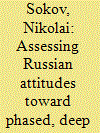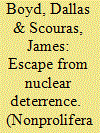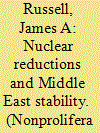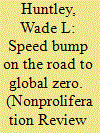|
|
|
Sort Order |
|
|
|
Items / Page
|
|
|
|
|
|
|
| Srl | Item |
| 1 |
ID:
123118


|
|
|
|
|
| Publication |
2013.
|
| Summary/Abstract |
As the United States and Russia contemplate the next stage of nuclear arms reductions beyond the 2010 New Strategic Arms Reduction Treaty, another issue enters the agenda-that of the impact of possible deep reductions on the shape of the global nuclear balance. As the gap between the US/Russian arsenals and the arsenals of "second-tier" nuclear weapon states narrows, the familiar shape of the global balance, which remains, to a large extent, bipolar, is likely to change. The article explores the Russian approach to the relationship between further US-Russian reductions and the prospect of "nuclear multipolarity," and assesses the relative weight of this issue in Russian arms control policy as well as the views on the two specific regional balances-the one in Europe (including UK and French nuclear weapons) and in Asia (the possible dynamic of the Russian-Chinese nuclear balance).
|
|
|
|
|
|
|
|
|
|
|
|
|
|
|
|
| 2 |
ID:
123120


|
|
|
|
|
| Publication |
2013.
|
| Summary/Abstract |
Significant nuclear reductions by the United States can affect other states in one of five ways: by directly altering their strategic calculations and postures; by indirectly altering their strategic calculations and postures by affecting the behavior of third-party states; by undermining formal US deterrence commitments; by eroding the United States's perceived ability to provide "informal" deterrence through the maintenance of an active global presence; and by creating normative pressure for states to emulate US nuclear reductions. Only the erosion of "informal" deterrence is likely to affect South Asia; to the extent that significant US nuclear reductions affect South Asia, then, their impact is likely to be destabilizing.
|
|
|
|
|
|
|
|
|
|
|
|
|
|
|
|
| 3 |
ID:
123123


|
|
|
|
|
| Publication |
2013.
|
| Summary/Abstract |
Since the post-World War II genesis of nuclear deterrence, two presidential initiatives have been presented to deliver humanity from the threat of its failure. The first was the Strategic Defense Initiative (SDI), a constellation of space- and ground-based systems that President Ronald Reagan envisioned would render nuclear weapons "impotent and obsolete." The second is President Barack Obama's roadmap to "a world without nuclear weapons," commonly referred to as "Global Zero." While these proposals appear to have little in common, deeper investigation reveals a number of provocative similarities in motivation and presentation. Moreover, both generated fierce debate, often with ideological overtones, about their strategic desirability and technical feasibility. We use these parallels, as well as prominent dissimilarities, to draw lessons from the SDI experience that can be applied to the debate over Global Zero.
|
|
|
|
|
|
|
|
|
|
|
|
|
|
|
|
| 4 |
ID:
123119


|
|
|
|
|
| Publication |
2013.
|
| Summary/Abstract |
The United States faces a series of strategic and policy conundrums as it attempts to promote strategic stability in the Persian Gulf and the wider Middle East. This article examines the relationship between a reduced US nuclear arsenal and strategic stability in the Persian Gulf and the Middle East. It argues that a series of interrelated political and military factors play a much more significant role in regional security and stability than the US strategic arsenal, which has never, with a few extraordinary exceptions, played a direct role in maintaining regional security. The United States has constructed a system of regional stability based on conventional deterrence and defense that has seen it forward base forces at various installations in the region in combination with efforts to arm, train, and equip host-nation militaries. Nuclear weapons have never played a prominent role in this regional system. Evidence presented in this article suggests that there is no compelling reason for the United States to abandon and/or modify the defensive system of conventional deterrence and defense by adding nuclear-backed guarantees to the mix.
|
|
|
|
|
|
|
|
|
|
|
|
|
|
|
|
| 5 |
ID:
123121


|
|
|
|
|
| Publication |
2013.
|
| Summary/Abstract |
Chinese writings on the workings of nuclear stability, deterrence, and coercion are thin and politicized. Nevertheless, it is possible to glean, from direct and inferential evidence, rather pessimistic conclusions regarding Chinese views of nuclear stability at low numbers. While China has been living with low numbers in its own arsenal for decades, today it views missile defense and advanced conventional weapons as the primary threat to nuclear stability. More generally, China views nuclear stability as wedded to political amity. Because none of these would be directly addressed through further US and Russian arsenal reductions, China is unlikely to view such reductions as particularly stabilizing. While there is little in Chinese writing to suggest lower US and Russian numbers would encourage a "race to parity," there are grounds to worry about China becoming more assertive as it gains confidence in Beijing's own increasingly secure second-strike forces.
|
|
|
|
|
|
|
|
|
|
|
|
|
|
|
|
| 6 |
ID:
123116


|
|
|
|
|
| Publication |
2013.
|
| Summary/Abstract |
President Barack Obama has outlined a course toward lower numbers of US nuclear weapons. Much attention has been paid to the US-Russian context, where deterrence is believed to be basically stable and conditions ripe for gradually reducing arsenals on both sides. But considerably less attention has been paid to the possible implications of lower nuclear numbers on other regions of the world and the reactions of both adversaries and US allies. If nuclear reductions are to be stabilizing and beneficial to security, reassurance and strengthened nonproliferation efforts in various regions need to accompany nuclear cuts. But the specific problems and remedies across regions vary. This article summarizes the results of a multi-author study. It concludes that regions with US allies and formal extended deterrence pledges may pose more vexing problems than those areas of the world without such close allies or commitments.
|
|
|
|
|
|
|
|
|
|
|
|
|
|
|
|
| 7 |
ID:
123122


|
|
|
|
|
| Publication |
2013.
|
| Summary/Abstract |
The prospect of the United States continuing to reduce the size of its nuclear arsenal to "very low numbers" has raised questions in Japan and South Korea, where US extended deterrence guarantees are premised on the "nuclear umbrella." In both countries, however, concerns focus less on numerical arsenal size than on the sufficiency of specific nuclear and non-nuclear capabilities to meet evolving threats and on the degree of broader US commitment to these alliances. This article assesses developments in US-Japan and US-South Korea relationships in response to the Obama administration's nuclear disarmament policies, focusing on how the evolutionary course of those relationships may in turn condition prospects for sustaining this US nuclear policy direction. The analysis finds that the challenges of deterrence credibility and allied reassurance are difficult and long-term, but also that US nuclear arsenal size is secondary to broader political, strategic, and military factors in meeting these challenges. The evaluation concludes that strong alliance relationships and strategic stability in East Asia can be maintained while the size of the US nuclear arsenal continues to decline, but also that deterioration of these relationships could imperil core US nuclear policy and nonproliferation objectives.
|
|
|
|
|
|
|
|
|
|
|
|
|
|
|
|
| 8 |
ID:
123117


|
|
|
|
|
| Publication |
2013.
|
| Summary/Abstract |
This article offers a survey of risks that might arise for strategic stability (defined as a situation with a low probability of major-power war) with the reduction of US and Russian nuclear arsenals to "low numbers" (defined as 1,000 or fewer nuclear weapons on each side). These risks might include US anti-cities targeting strategies that are harmful to the credibility of extended deterrence; renewed European anxiety about a US-Russian condominium; greater vulnerability to Russian noncompliance with agreed obligations; incentives to adopt destabilizing "launch-on-warning" strategies; a potential stimulus to nuclear proliferation; perceptions of a US disengagement from extended deterrence; increased likelihood of non-nuclear arms competitions and conflicts; and controversial pressures on the UK and French nuclear forces. Observers in North Atlantic Treaty Organization (NATO) states who consider such risks significant have cited four possible measures that might help to contain them: sustained basing of US nonstrategic nuclear weapons in Europe; maintaining a balanced US strategic nuclear force posture; high-readiness means to reconstitute US nuclear forces; and enhanced US and allied non-nuclear military capabilities. These concrete measures might complement the consultations with the NATO allies that the United States would in all likelihood seek with respect to such important adjustments in its deterrence and defense posture.
|
|
|
|
|
|
|
|
|
|
|
|
|
|
|
|
|
|
|
|
|